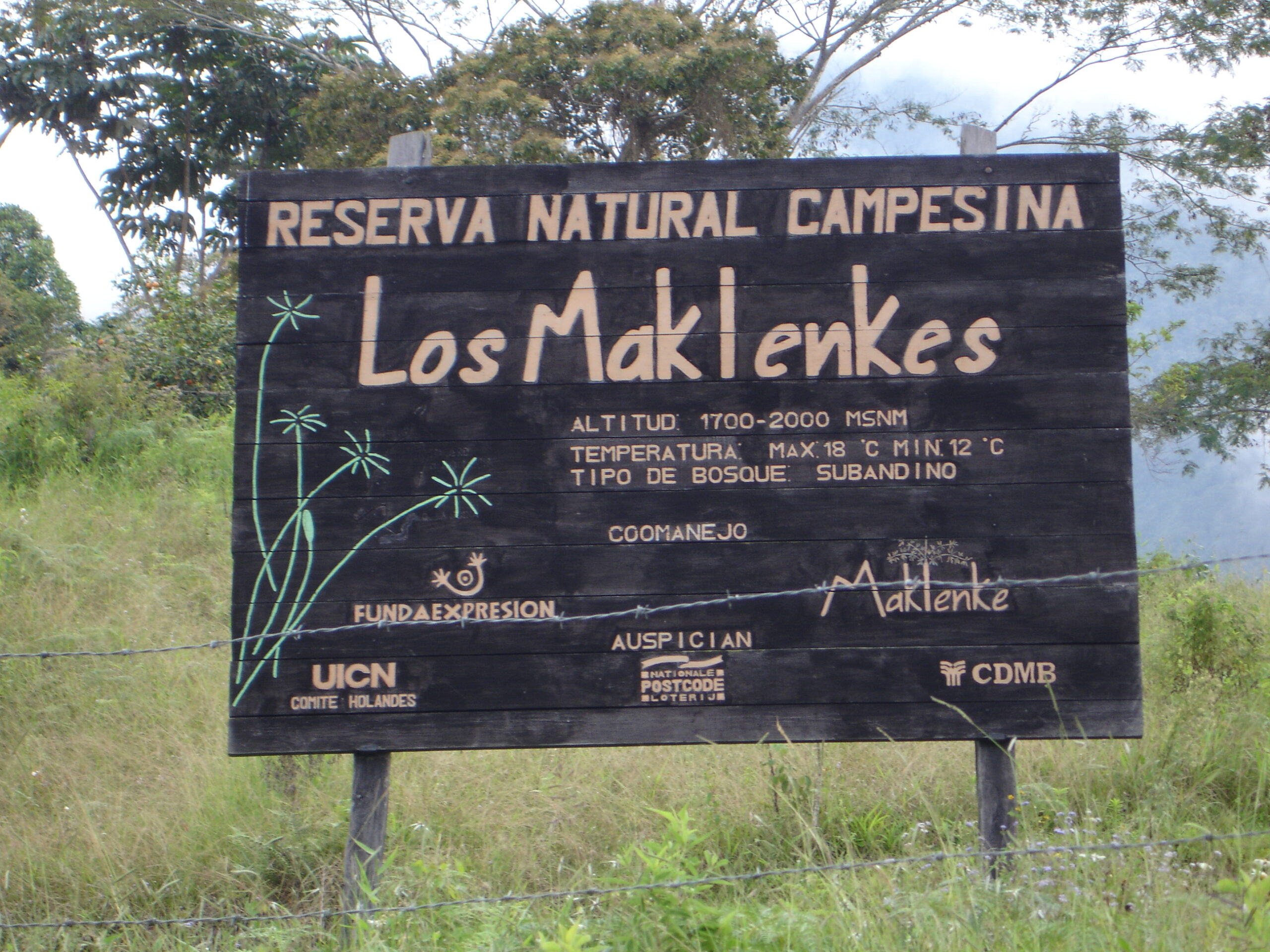Picture taken from: Rural Sociology Wageningen University
In the warm mountains of Floridablanca, Santander, Colombia, there is a gem of biodiversity protected by the hands and hearts of farmers: the Farmer Natural Reserve Los Maklenkes. This space, located in the hill La Judía, was born in 2001 thanks to the efforts of Gustavo Saavedra, his family and four other farmer families concerned about the indiscriminate hunting of endangered species such as the spectacled bear [1][2]. The reserve is part of the Collective of Farmers and Community Reserves of Santander [3].
In 2005, they managed to have 920 hectares of Cerro La Judía included in the Floridablanca Territorial Planning Plan as a reserve area [1]. The Maklenkes were part of the social and community Minga in defense of the environmental heritage and food sovereignty of Santander in 2006, for whose inauguration they held a native tree planting day [4].
The Maklenkes reserve, whose name comes from the Maklenke, a typical timber tree of the hill La Judía area, between 1,700 and 2,000 meters high [2], is proposed as an alternative to “conservation” models that cause displacement and uprooting of communities due to the purchase and eviction of land [4]. They do this through permaculture, agroecology, bioconstruction and rainwater harvesting projects, promoting energy autonomy and food sovereignty. In addition to their activities, it should be noted that their very existence is a contribution to peace and sustainability. They have and have had to resist violence by, for example, negotiating with armed actors through delegates to ensure their permanence in the area as a community, avoiding being forcibly displaced [5].
The reserve is home to an impressive variety of wildlife, including 375 species of birds, 120 species of trees and 40 species of grasses [2]. It was declared an Area of Importance for Bird Conservation (Aicas) by Bird Life International and the Alexander Humboldt Institute [1]. Therefore, one of its main activities is to identify and monitor threatened and endangered birds protected in the area of its peasant reserve [5]. Among these birds, the last 10 thousand specimens of the Mountain Monkey stand out, which makes Los Maklenkes an Area of Importance for Bird Conservation [2]. Additionally, there is a bird school through which children and young people learn to value and protect local biodiversity [6].
Furthermore, the bioconstruction of an access gate to the reserve using the rammed earth technique is an example of the transmission of traditional knowledge between generations [6], which contributes to the already identified erosion of traditional knowledge and practices, which they determine as a threat to biodiversity, heritage, and culture [5]. In addition, rural students and teachers are trained in the reserve in its preservation [2].
Since 2016, the Maklenkes have participated together with other organizations from Colombia in the Community Conservation Resilience Initiative (CCRI) [5]. The support of organizations such as the Asomaklenke Foundation, the International Union for Conservation of Nature (IUCN) of the Netherlands and the Collective of Peasant and Community Reserves of Santander has been fundamental to the success of the initiative [2], [6]. In 2021, they were showcased as one of the community experiences of Just Energy Transition [6], which highlights the production of energy with solar panels, their cooperative and solidarity structure, and agroecology, in addition to the technical challenges with the panels and the limitations for the participation of women in community activities.
The Farmer Nature Reserve Los Maklenkes is an example of how local communities can be key actors in the conservation of biodiversity. Their work demonstrates that environmental protection and sustainability of life can go hand in hand, generating benefits for both nature and people. Community water management, agroecology, and community monitoring of biodiversity are some pillars of this conservation process. 🌾
SOURCES
[1] El Tiempo, ‘Construyen reserva natural de la sociedad civil para proteger selva húmeda y bosque en Santander’, El Tiempo. Accessed: Dec. 15, 2024. [Online]. Available: https://www.eltiempo.com/archivo/documento/CMS-3471187
[2] Viaja por Colombia, ‘Campesinos de Floridablanca en Santander, crean Reserva Natural – Noticias’, Viaja por Colombia. Accessed: Dec. 15, 2024. [Online]. Available: https://viajaporcolombia.com/noticias/campesinos-de-floridablanca-en-santander-crean-reserva-natural_2321/
[3] behiquealto, Santander, Colombia. Reservas Campesinas de Santander _ Para Darle Vida A La Vida _, (Mar. 18, 2020). Accessed: Dec. 15, 2024. [Online Video]. Available: https://www.youtube.com/watch?v=wYfKgPPhZLY
[4] C. G. Roa and A. J. Rankin, ‘Minga social y comunitaria en defensa del patrimonio ambiental y la soberanía alimentaria. Santander, 3 – 6 de junio de 2006’, Corporación Grupo Semillas Colombia. Accessed: Dec. 15, 2024. [Online]. Available: https://semillas.org.co/es/revista/minga-social-y-comunitaria-en-defensa-del-patrimonio-ambiental-y-la-soberana-alimentaria-santander-3-6-de-junio-de-2006
[5] T. Roa Avendaño and D. A. Cardona, ‘La Iniciativa de Resiliencia de Conservación Comunitaria en Colombia’, Global Forest Coalition. Accessed: Dec. 15, 2024. [Online]. Available: https://globalforestcoalition.org/es/community-conservation-colombia/
[6] ‘Energías para compartir, energías para el buen vivir’, Exhibición virtual de experiencias comunitarias de Transición Energética Justa. Accessed: Dec. 15, 2024. [Online]. Available: https://transicionenergeticajusta.org/energias-para-compartir-energias-para-el-buen-vivir-2/

Leave a Reply